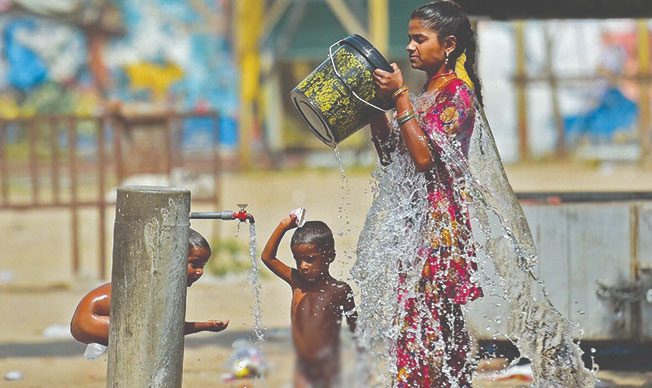India, on the verge of becoming the most populous country in the world, faces the risk of reaching human survival limits due to experiencing extreme heatwaves with increasing frequency.
According to New Delhi television, the Indian Meteorological Department forecasts that temperatures in the country will rise in the coming weeks after New Delhi just had its hottest February since 1901. This phenomenon raises concerns that last year’s record heatwave may recur, causing widespread crop damage and prolonged power outages.
When temperatures reach 50 degrees Celsius, this is considered the upper limit of human endurance under any conditions. However, the 1.4 billion people in India are more vulnerable as they are trapped in crowded cities and live in homes without air conditioning or air purifiers.
“The combination of temperature and humidity will pose dangers to humans here. India is often more humid than places with equivalent temperatures, like the Sahara Desert. This means that the cooling process through sweating is less effective or completely ineffective,” explained Kieran Hunt, a climate scientist at the University of Reading.

People cool off at a public water fountain during the heat in Allahabad, India, on April 28, 2022. (Photo: AFP/TTXVN).
A report in November 2022 by the World Bank (WB) warned that India could become one of the first places in the world with wet bulb temperatures exceeding 35 degrees Celsius.
Wet bulb temperature is a type of apparent temperature used to estimate the effect of temperature, humidity, wind speed, and infrared and visible radiation on humans. According to a 2010 study, a wet bulb temperature of 35 degrees Celsius would be the safety limit that the human body can withstand.
While no country is immune to the effects of global warming, there are many reasons why India stands out with more intense heatwaves.
In India, heatwave temperatures are divided into two components – the average monthly baseline temperature and the abnormal temperatures occurring due to specific weather phenomena at a given time. In India, since the pre-industrial period, the baseline temperature has risen by about 1.5 degrees Celsius. Additionally, other compounding factors such as deforestation and the urban heat island effect contribute to an additional temperature increase of 2 degrees Celsius.
With the baseline temperature already too high, above 40 degrees Celsius, even a slight increase can push people closer to their survival limits.
More intense heatwaves, where higher temperatures last longer, tend to lead to more fatalities. By comparison, the only places on the planet with temperatures equivalent to India in May are the Sahara Desert and parts of the Arabian Peninsula. However, these areas have extremely low population densities. Thus, the mortality rate there is not as high as in India, especially in the context of India’s rapidly growing population over the past few decades.
Not only does it affect human lives, prolonged heat also has widespread consequences for Indian society. Heatwaves significantly dry out the soil and impact water security due to drought.
Abnormal hot periods lead to decreased labor productivity, especially in outdoor sectors like agriculture and construction; increase cooling demands, which overload the power grid, and contribute to rising greenhouse gas emissions.
Although wet bulb temperatures in India rarely exceed 32 degrees Celsius and temperatures need to rise much more to reach the human survival limit, the increasing pace of urbanization, coupled with the urban heat island effect and global warming, means the risk of deadly heatwaves looms ever closer and is increasing.


















































